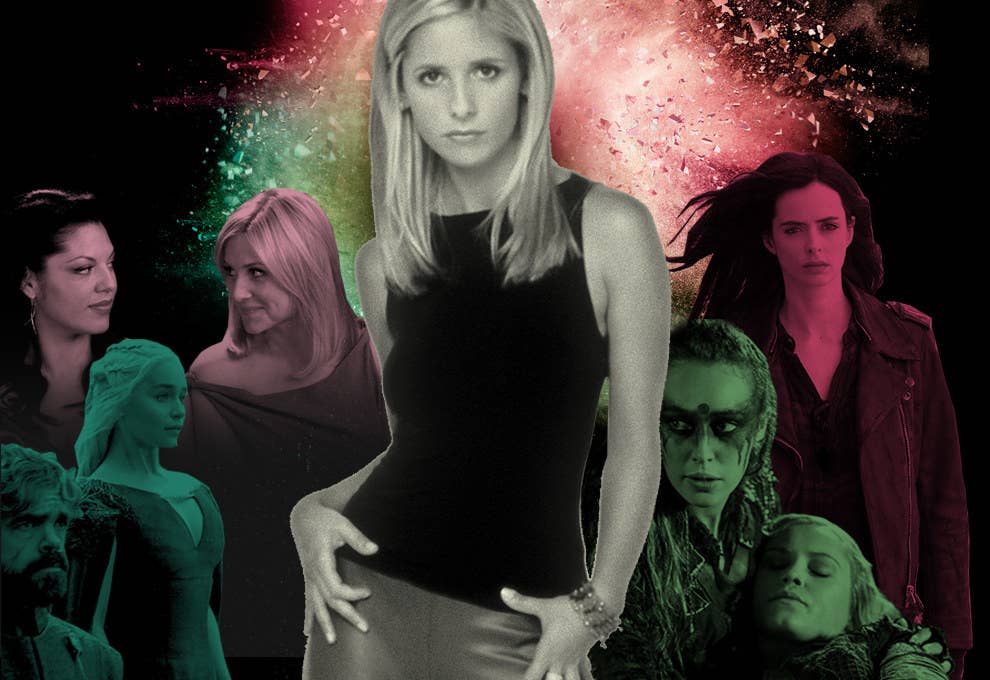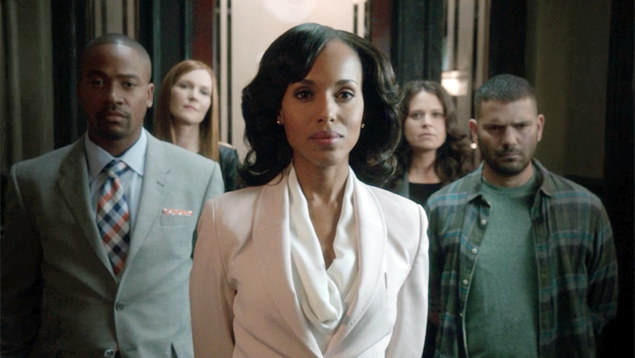
If you’ve ever had a show break your heart with the death of a major character, Buffy the Vampire Slayer is at least partly to blame. If you’ve ever rejoiced or suffered through a musical episode of a not-musical show, that may be on Buffy, too. There was the fearless meshing of genres; the playful take on dialogue; the commitment to a style of longform storytelling that turned the whole cast of characters into cultural icons; the groundbreaking queer storyline that paved the way for many more LGBT+ stories and characters to come. Whether you look at the sum of its parts or you consider the whole, Buffy’s is a lofty legacy to carry. Twenty years in, that’s truer now than ever.
When the series made its TV debut late in the winter of 1997, it famously flipped horror conventions: The conventionally attractive blonde girl wasn't preyed upon in a dark alley after meeting a threatening stranger. Rather than fall victim, she kicked ass. She wielded a stake; she killed the monster; she literally stomped the patriarchy.

According to creator Joss Whedon, Buffy’s mission statement was “the joy of female power.” In practice, it was both the joys and the tribulations. Though Buffy had its share of villains throughout the years, the most memorable follow the show’s classic form: They are an enemy of women, and Buffy must take them down. Whether against a misogynistic classmate, a trio of murderous white nerd men personifying an all-too-real toxic masculinity, or a nasty preacher (Nathan Fillion) with a fanatical hatred of womankind, Buffy Summers (Sarah Michelle Gellar) did her stomping. The show lived and breathed the credo that girls are powerful — a concept that sounds easy but is still lacking in Hollywood, even with the progress that’s been made. For a long time, Buffy was one of the central examples of what it meant to be a “feminist TV show” in the ’90s. It didn’t just define those conversations in pop culture — it helped to jump-start them into the 21st century.
Buffy herself was nothing less than a masterpiece. Her heroism and sparky bravado coexisted with her deeply felt pain and flaws, along with that handy ability to throw you across a room. Buffy was a pioneer figure in her own right, and the series filled a cultural void for formidable roles for women in an industry that had long been begging for absolution. It’s a meaningful show to a lot of people, in part because it married premise and execution so beautifully, allowing its stories to take on a mantle of importance bigger than itself.
Before she made a single episode of television, Shonda Rhimes binge-watched Buffy in its entirety. “For me, that was a very inspiring show, in terms of what was there and what was possible,” she told The Hollywood Reporter in 2014. You can see subtle echoes of Buffy in every TV show Rhimes has ever made. Grey’s Anatomy, especially, is 13 seasons in and remains committed to longform character-driven storytelling amplified with operatic plot choices. Consider main character Meredith Grey: Not unlike Buffy before her, she’s survived countless emotional apocalypses, including a plane crash, the deaths of nearly everyone in her immediate family, a random senseless beating at the hands of a patient, a bomb incident, and a mass shooting. But while Grey’s remains committed to the melodrama, it's also just as devoted to who Meredith is in the context of the trauma she endures. That’s good character writing 101, but it’s also Buffy 101.
ShondaLand used the foundation Buffy laid down and built a whole city of skyscrapers on top of it.
The Rhimes-produced Scandal and How to Get Away With Murder — as well as Off the Map, Private Practice, and The Catch — all carry bits of Buffy DNA with them, too. Whether it’s quippy dialogue (see the banter of Pope & Associates), a playful ensemble riding out small apocalypses (think the cliffhangers in any of the above-mentioned shows), or the trademark ruthlessness with which both Rhimes and Whedon have killed off major characters (YEARS-OLD SPOILER ALERT: Like Grey’s’ George and Derek, and Scandal’s James). ShondaLand used the foundation Buffy laid down and built a whole city of skyscrapers on top of it.
ShondaLand is, of course, not the only place where Buffy’s influence is evident. You can see it too in sprawling fandom empires, in teen supernatural romances, and in genre risk takers. It’s present in the spiky, conflicted action heroines whose journeys involve tearing down the world’s most poisonous power structures. Buffy’s descendants are everywhere you look — in Katniss Everdeen of The Hunger Games, and in the ensemble of The 100; in the supernatural “Scooby” romps of Teen Wolf; in the system toppling and romances of Veronica Mars; in the genre-challenging explorations of heroism and death embedded in Lost and Game of Thrones; in the woman-championing discussions of autonomy in Orphan Black; in the chatty array of friends in Happy Endings; in Crazyhead’s ragtag demon hunters; in Twilight’s vampire romances; and unmistakably in the darkness and power of Jessica Jones.
In Buffy’s fourth season, when Willow Rosenberg (Alyson Hannigan) revealed that she was falling for Amber Benson’s Tara Maclay, it wasn’t the first time a woman had loved another woman on TV. But it was a landmark moment in queer representation all the same — and one that progressed and deepened as Willow and Tara’s relationship did. This was network television in the very early ’00s, after all, and it was rare for same-sex relationships to be afforded the level of intimacy Willow and Tara enjoyed — so rare, in fact, that Whedon famously threatened to quit the show if The WB didn’t let the couple kiss onscreen. Whedon won the kiss, and audiences were invited to rejoice in a romance that remains one of the most endearing of the era. Today, the offshoots of their love aren’t overt, but rather implied — in Grey’s Anatomy’s Callie and Arizona; in Sense8’s Nomi and Amanita; in Faking It’s Karma and Amy. Not to mention in Pretty Little Liars’ Emily and Maya, who coincidentally was played by former Buffy slayer Bianca Lawson.
The relationship’s execution was not perfect, of course. In a move marred by a long (and continuing) history of queer women being slaughtered onscreen, Tara was killed off suddenly and brutally at the end of the sixth season, cradled in Willow’s arms. And in the aftermath, Willow morphed into the season’s “big bad,” going on a vengeful killing spree that saw a longtime hero become the villain.
Buffy stands in the middle of it all as a reminder of the progress that’s been made and the work there is still left to do.
Whereas Willow was a central yet supporting character in her series, in 2015, The CW’s teen apocalypse drama The 100 used the ground Buffy paved to make its main character, Clarke (Eliza Taylor), bisexual. Her love interest, Lexa (Alycia Debnam-Carey), was also killed suddenly — in a scene that almost eerily mirrors Tara’s death. The show’s fandom erupted in response, demanding more thoughtful representation of LGBT+ characters onscreen.
Some things change drastically in 20 years; some stay the same. Buffy stands in the middle of it all as a reminder of the progress that’s been made and the work there is still left to do.
But Willow and Tara, as with many other aspects of the show, beg the question: If disciples of Buffy are everywhere, what does that mean decades after the fact? Buffy helped inspire a growth of more than just a select few examples of feminist-influenced art in the pop culture landscape. In a strange Catch-22 that perfectly fits into our present-day modes of discussing pop culture, Buffy has had so much impact on culture that it makes itself look retrograde as a result.

Today, the idea of a small white woman kicking ass is no longer revolutionary — in fact, in many cases it’s become the standard demanded of Hollywood. In the 20 years since Buffy’s debut, the conversation that created Buffy Summers in the first place has changed and become more intersectional. Its victories still stand — but so do its blemishes, including but not limited to a severe lack of fleshed-out (and not-dead) characters of color.
Rhimes may have been inspired in part by Buffy, but she took things to a new and different level when she created Olivia Pope, the exceptionally capable but intensely flawed DC “fixer,” who made her debut in 2012. Olivia was the first black female lead on network television in nearly 40 years. She too filled a void, and her popularity proved that women of color are just as capable of carrying shows as captivating and complex main characters.
TV did not stagnate after Buffy. On the contrary, the industry took what it preached, welded it together with everything else that was happening in the world, and built a new landscape with the materials. So when we talk about Buffy now, we should be talking about all that TV has accomplished thanks to its legacy — but let’s not forget where it all started: with one writer flipping convention and assigning power to someone pop culture often stripped of it. In order to truly make the most of all the innovation Buffy helped inspire, we need to nurture that first spark.
